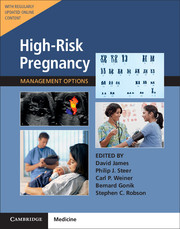Book contents
- Frontmatter
- Contents
- List of Contributors
- Preface
- Section 1 Prepregnancy Problems
- Section 2 Early Prenatal Problems
- Section 3 Late Prenatal – Fetal Problems
- Section 4 Problems Associated with Infection
- Section 5 Late Pregnancy – Maternal Problems
- Section 6 Late Prenatal – Obstetric Problems
- 52 Abdominal Pain in Pregnancy
- 53 Nonmalignant Gynecology in Pregnancy
- 54 Bleeding in Late Pregnancy
- 55 Multiple Pregnancy
- 56 Threatened and Actual Preterm Labor
- 57 Prelabor Rupture of the Membranes
- 58 Breech Presentation, Unstable Lie, Malpresentation, and Malpositions
- 59 Prolonged Pregnancy
- 60 Induction of Labor and Termination of the Previable Pregnancy
- 61 Dysfunctional Labor
- 62 Shoulder Dystocia
- 63 Fetal Compromise in Labor
- 64 Neuraxial Analgesia and Anesthesia in Obstetrics
- 65 Perineal Repair and Pelvic Floor Injury
- 66 Assisted Vaginal Delivery
- 67 Delivery After Previous Cesarean Section
- 68 Cesarean Section
- Section 7 Postnatal Problems
- Section 8 Normal Values
- Index
63 - Fetal Compromise in Labor
from Section 6 - Late Prenatal – Obstetric Problems
- Frontmatter
- Contents
- List of Contributors
- Preface
- Section 1 Prepregnancy Problems
- Section 2 Early Prenatal Problems
- Section 3 Late Prenatal – Fetal Problems
- Section 4 Problems Associated with Infection
- Section 5 Late Pregnancy – Maternal Problems
- Section 6 Late Prenatal – Obstetric Problems
- 52 Abdominal Pain in Pregnancy
- 53 Nonmalignant Gynecology in Pregnancy
- 54 Bleeding in Late Pregnancy
- 55 Multiple Pregnancy
- 56 Threatened and Actual Preterm Labor
- 57 Prelabor Rupture of the Membranes
- 58 Breech Presentation, Unstable Lie, Malpresentation, and Malpositions
- 59 Prolonged Pregnancy
- 60 Induction of Labor and Termination of the Previable Pregnancy
- 61 Dysfunctional Labor
- 62 Shoulder Dystocia
- 63 Fetal Compromise in Labor
- 64 Neuraxial Analgesia and Anesthesia in Obstetrics
- 65 Perineal Repair and Pelvic Floor Injury
- 66 Assisted Vaginal Delivery
- 67 Delivery After Previous Cesarean Section
- 68 Cesarean Section
- Section 7 Postnatal Problems
- Section 8 Normal Values
- Index
Summary
Introduction
In previous editions, this chapter was called Fetal Distress. This is a term that is still commonly used, but is difficult to define. For many years it was taken to indicate the presence of hypoxia, leading to fetal acidosis. However, we have become more aware of the importance to the fetus of variables such as maternal/ fetal temperature, chorioamnionitis, passage of meconium into the amniotic fluid (which can lead to meconium aspiration syndrome), and trauma, including events such as cord prolapse and head compression (which can occur from excessive molding even in spontaneous labor, but is more commonly associated with forceps and difficult cesarean deliveries). To include all of these under the heading of “fetal distress” is not helpful; it is similar to labeling everyone in an adult intensive care unit as “ill” irrespective of whether they have cardiovascular, neurological, traumatic, or infectious problems. For this reason, we have chosen to retitle the chapter Fetal Compromise, and we will address the various stresses which can lead to fetal compromise separately and in combination.
Monitoring fetal wellbeing during labor is difficult, because access to the baby is limited. The easiest parameter to measure is the fetal heart rate (FHR). The first reported awareness of the fetal heart sounds was by the French physician Marsac in the seventeenth century, and in 1818 Francois Mayor, a Swiss surgeon, and in 1821 a French nobleman, Jean- Alexandre Le Jumeau, Vicomte de Kergaradec, independently confirmed the audible beating of the fetal heart. An essay on “obstetric auscultation, or means of detecting life or death of a foetus before birth” by Evory Kennedy of Dublin was published in 1834. By 1906, Cremer had described the detection of the fetal electrocardiogram (ECG), using electrodes placed on the mother's abdomen and in her vagina. However, this signal was very small and usually swamped by electrical activity from the mother's rectus muscles, and it was not until the 1960s that the introduction by Edward Hon of fetal scalp electrodes passed through the cervix produced a sufficiently large and clear signal for continuous intrapartum monitoring of the FHR.
- Type
- Chapter
- Information
- High-Risk Pregnancy: Management OptionsFive-Year Institutional Subscription with Online Updates, pp. 1789 - 1810Publisher: Cambridge University PressFirst published in: 2017



